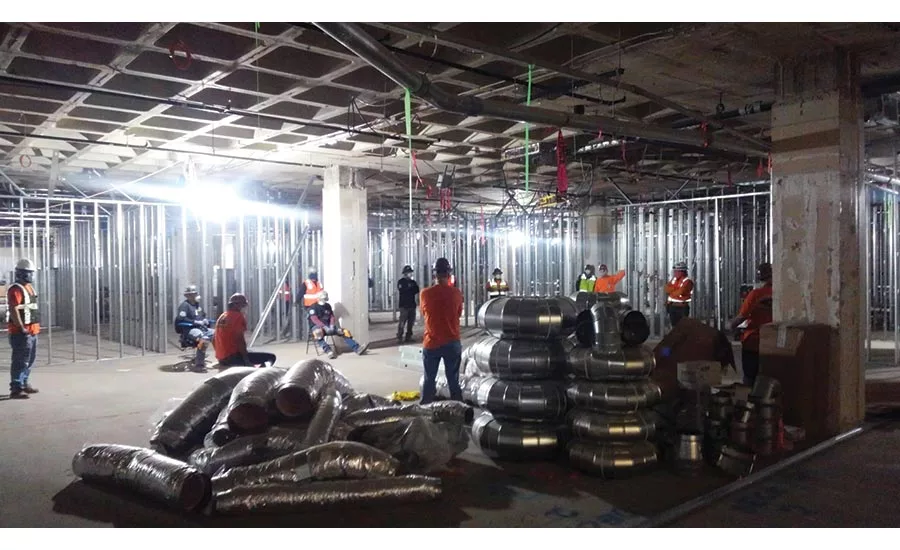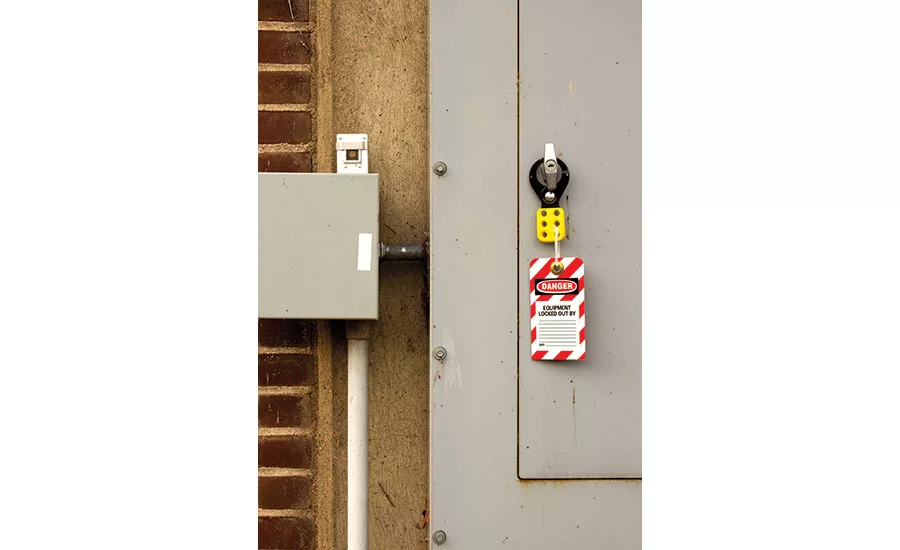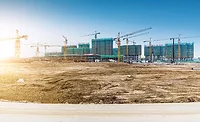Site Selection
3 keys to site selection for food and beverage facilities
Site characteristics, hazards and ongoing pandemic affect the process

To help protect employees and contractors on job sites, Gray is emphasizing social distancing policies whenever possible.
Photo courtesy of Gray

Understanding and managing the flow of people, vehicles and materials in and out of a processing facility is an important part of the site selection process.
Photo courtesy of Getty Images

A Gray jobsite meeting while implementing social distancing. In cases where workers need to be in close proximity, supervisory approval is required.
Photo courtesy of Gray

Comprehensive lockout/tagout procedures help protect plant employees, construction personnel and contractors from potential electrical hazards.
Photo courtesy of Getty Images
When processors work with design-build firms to identify sites for and begin work on new construction projects, safety concerns traditionally involve factors such as ingress/egress, law enforcement and fire/EMS coverage and electrical and mechanical hazards.
But the ongoing coronavirus pandemic and potential disaster scenarios add another layer of complexity to the process. Let’s take a look at how processors and design-build firms are handling a number of different challenges.
Key No. 1: Fundamental criteria
There are a number of criteria involved in site selection, and it’s a complicated formula to solve because everything from the available workforce to shipping and receiving concerns can be a deal breaker. When it comes to safety and security, processors face advantages and disadvantages compared with other types of construction.
Generally speaking, food and beverage plants need large sites that are often located outside of towns or in rural areas. That allows for planning and customization of ingress/egress routes for both personnel and materials, such as ingredients or finished goods. If you’re working with a site that is in a rural area, you probably don’t have to worry about neighboring facilities or limitations on how you are able to install fencing.
But if you’re close to or in a town, then some of those factors become more complicated. Controlling site access is more difficult in a high-traffic area with a large population. Privacy and lines of site to the facility are harder to control as well.
Identifying the challenges of each type of site and planning out how people and products will be able to get on- or off-site is a critical first step, says Mary Frances Stotler, director of sustainability, project manager and senior partner at Dennis Group.
“It’s important to identify and understand ingress/egress areas, local zoning requirements and traffic patterns on public thoroughfares,” says Stotler. “Assessing whether the infrastructure is capable of safely and permanently handling employee and truck traffic can identify if costly upgrades will need to be made now or in the future. Alternative routes should also be mapped in the event that a primary route is blocked or not usable.”
While the characteristics of the site play a role in understanding the logistical challenges, the local transportation infrastructure is likely to play even more of a role. A rural area may have one road that runs past the site, while an urban, suburban or exurban location will likely have a number of roads that run near the facility on most if not all sides. That requires designating entry and exit points and which roads you will allow access from to the site.
It also leads to decisions such as separate entries and/or exits for employees, visitors, tradespeople, vendors and trucking. If the rural site needs to bring everything through one or two entrances, another type of site may allow for designated entrances for each category of visitor to the site. That allows for greater control of how people and materials are entering or exiting, but requires more resources for security, logistics and planning.
“It’s not so much like the piece of land itself, but it’s more looking at the roads and what the logistics or what that flow is going to look like on the site,” says Tammi McAllister, core team leader, food business unit, CRB.
Those security concerns will often help determine the details of what you need in a site and how large you need the site to be, says Courtney Dunbar, site selection and economic development leader, Burns & McDonnell.
“Depending upon the securitization method, it could end up expanding our acreage, we may need to have more buffer, we may need to have ancillary facilities that are located on the property for storage purposes, we may need to have a certain form of fencing or a certain form of 24-hour security that is present,” says Dunbar.
In addition to on-site security decisions and planning, understanding the resources provided by the local municipality is an important piece of information. Police, fire and EMS coverage can vary dramatically based on the location of the plant. Food plants also use a number of dangerous chemicals, such as ammonia, and smaller or rural fire departments may not be equipped to handle them, says Stotler.
“If the local municipalities cannot handle hazmat incidents, a processor may be dealing with a regional responder that would be located a much greater distance from the plant site, delaying response times,” she says.
McAllister points out the importance of involving the local fire marshal early on to understand what they will need, including firetruck hook-ups and connection points.
“They also will have requests based on how we’re designing the building, such as making sure that they have potentially a fire road all the way around the building,” she says. “Even if it’s not a road that is normally accessed, they will have specific requests as well. “
Key No. 2: Electrical and Mechanical Hazards
As you move from site selection and planning into construction, electrical and mechanical hazards become a concern. With plant employees, design-build firm employees, contractors and subcontractors all coming on the site at different stages of the process, understanding the potential hazards and developing a plan for safely navigating them is critical.
“Each site should have its own site-specific orientation,” says Tim Williams, director of project management, Dean Snyder Construction. “And not just the owner’s orientation because there are two different types of processes that are going on on these projects.”
In addition to the initial orientation, ongoing orientations help ensure that everyone on-site is aware of potential hazards. Daily meetings and plans inform workers who will be on-site for a long time, while orientations that are adapted to the project phases ensure that contractors or workers who are coming on-site for specific tasks are kept up to speed.
“All tasks that are performed on our site are accompanied by a daily task specific plan that addresses the identified hazards and prescribes the proper hazard abatement required to perform the work,” says Tom O’Connor Jr., corporate safety director, Shambaugh & Son L.P., an EMCOR company. “No matter the complexity or the length of the task, all work is required to have this comprehensive plan.”
For new construction sites, utilities to the site should be confirmed against their documentation to ensure everyone knows where they are and how to access them. On renovation or rebuild projects, documentation is often the biggest challenge because the as-built drawings may or may not be accurate, so you have to trust, but verify, says Jim Grant, vice president of safety and field operations at Gray.
“We might not have good as-builts to go by, so you have to verify and walk utilities down and make sure you understand exactly what it is, where it’s going, how do you disconnect it? How do you lock and tag it out correctly?”
Temporary power needed in the early stages of construction adds its own set of challenges. Not only does it create additional live power sources to be mindful of, but it also requires extension cord runs that can create tripping hazards. Shambaugh mitigates this by using battery-powered tools whenever possible, as well as supplying more sources of power for tradespeople to cut down on long extension cord runs. In addition, lighting and temporary power need to be factored into access areas for equipment that comes on-site.
“With the amount of large equipment coming to site, the protection of overhead, data and communication, and high-voltage is critical,” says O’Connor. “This is achieved by controlling the flow of traffic, installing signage and careful planning.”
Communication is critical in dealing with these challenges. Workers have to be kept in the know as you are bringing on temporary power or bringing site utilities online. If you don’t have good documentation for everything on the site, someone in one area may not realize what’s going on in another area, creating a potential safety hazard.
“Everybody on the team has to know what the schedule is because you may be bringing power for a whole loop that’s coming from two different power sources,” says Williams of Dean Snyder Construction. “Some may be overhead and some may be underground, and then you still need site utilities at the time. So making sure everything is marked, your dig permits have to be managed properly—it’s the hidden dangers that get you in trouble.
“Most of these projects are usually done on a fast-track basis anyway. So you’ve got a multitude of different trades all trying to work in the same area at same time.”
As Williams mentioned, the hidden dangers are potentially the most troublesome. Identifying and documenting them needs to be another element of the hazard mitigation plan. That includes empowering anyone on the site to speak up when they encounter a hazard, then evaluating and documenting how to mitigate it and guard against it happening again in the future. Drawing on resources beyond just the construction team helps ensure you have the best knowledge available to handle such situations.
“OSHA is a good resource to start with,” says Dennis Whipple, electrical design-build manager, Shambaugh & Son. “They have seen most everything at least once. Contractors live with these exposures, so we know what to look for and what to expect. The plant operations team is an excellent resource for lessons learned. They see the daily maintenance issues that contractors may not see.”
A final area of electrical and mechanical hazards to keep in mind is what happens when vendors start coming on-site or the plant begins to switch over to production. Food plants are often scheduled to start running before everything is sealed up, which means vendors and engineers are coming on-site to commission and start up equipment while construction is still going on.
Williams points out that one challenge he often sees is vendors from outside the country not being aware of safety requirements here, and that those must be communicated in advance.
“It’s getting better, but when you have vendors coming from overseas that are bringing equipment in to start it up, the culture and the communication gets overlooked a lot of times,” he says. “Sometimes their safety cultures are not the same as ours. Getting communication to vendors prior to them showing up on-site is commonly overlooked and needs to be stressed more.”
Key No. 3: Pandemics and other disasters
The security and safety aspects of the site selection process include evaluating a number of threats, such as physical violence, terrorism or intentional adulteration of ingredients or other elements of the production process. But they also include planning for possible natural disasters, which can’t be fought against by adding more security or implementing an anonymous reporting system for potentially problematic coworkers.
Depending on the region, hurricanes, tornadoes, blizzards, fires or earthquakes can all be part of the evaluation process. Drought can also be a concern for water-heavy production.
“We’re going to look at natural disaster sorts of occurrences as well,” says Burns & McDonnell’s Dunbar. “Because again, those are safety/security related scenarios. So there are instances where producing product we may not decide to locate along a fault line, for example. Or an area we know that there are significant tornadic or other forms of seismic activity, etc. that we believe could end up posing a risk to the actual overall operation.”
While some of these concerns may result in eliminating a site entirely, others can be mitigated based on the severity or frequency.
“Threats can be either man-made or natural, and those leading the site selection efforts should highlight mitigation strategies necessary in areas that are susceptible to natural disasters including drought, hurricanes, earthquakes, flooding or tornadoes,” says Dennis Group’s Stotler.
While disasters have been part of the site selection and planning process for a long time, the coronavirus pandemic that hit the United States in early 2020 has affected the construction process. Most construction personnel are considered essential, especially for construction of food plants, so they are still working while the pandemic is ongoing.
While processors and design-build firms are used to dealing with challenges such as flu season potentially causing a number of workers to be out sick, the coronavirus pandemic is an entirely different challenge. The most effective procedure for fighting it is staying at home and maintaining distance from other people, but those are in direct opposition to construction. You can’t build a processing facility remotely, and workers often need to be working together in confined spaces.
Design-build firms are adapting in a number of ways, says Grant from Gray. They are taking steps such as temperature taking when people come on-site and trying to maintain 6 feet of separation whenever possible. Site teams are also resequencing work or even delaying it to help avoid crowds of workers.
“Sometimes you might get 15 to 20 people that arrive on your job site that are brand new,” he says. “Of course, you can’t put all those people into a trailer and give them your typical orientation. So we’ve had to adjust for the social distancing piece, to make sure that we’re communicating to them and making them aware of the project requirements.”
Grant’s coworker Greg Janzow, director of food safety for Gray, points out that while the company is taking steps to protect its workers and everyone else on-site, it is adjusting on the fly as situations change.
“This is an incredibly dynamic situation,” says Janzow. “We can write down the best plan we can, but there could still be questions that come up or situations that might need to be looked at.
“We have a method, a very clear method in place to be able to evaluate and figure out through a chain of command and decision making and input to see that we are being as diligent as we can and as compliant as we can with that overall preparedness plan.”
For more information:
Dennis Group, www.dennisgroup.com
CRB, www.crbusa.com
Burns & McDonnell, www.burnsmcd.com
Gray, www.gray.com
Dean Snyder Construction, www.deansnyder.com
Shambaugh & Son, www.shambaugh.com
Looking for a reprint of this article?
From high-res PDFs to custom plaques, order your copy today!








